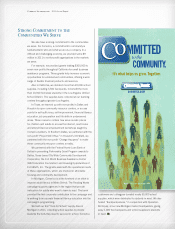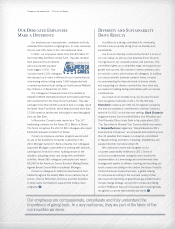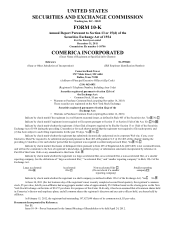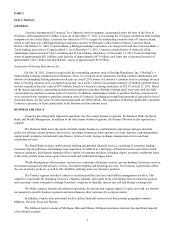Comerica 2011 Annual Report Download - page 16
Download and view the complete annual report
Please find page 16 of the 2011 Comerica annual report below. You can navigate through the pages in the report by either clicking on the pages listed below, or by using the keyword search tool below to find specific information within the annual report.6
Significantly undercapitalized depository institutions are subject to a number of requirements and restrictions.
Specifically, such a depository institution may be required to do one or more of the following, among other things: sell
sufficient voting stock to become adequately capitalized, reduce the interest rates it pays on deposits, reduce its rate of asset
growth, dismiss certain senior executive officers or directors, or stop accepting deposits from correspondent banks. Critically
undercapitalized institutions are subject to the appointment of a receiver or conservator or such other action as the FDIC and
the applicable federal banking agency shall determine appropriate.
As an additional means to identify problems in the financial management of depository institutions, FDICIA requires
federal bank regulatory agencies to establish certain non-capital safety and soundness standards for institutions any such
agency supervises. The standards relate generally to, among others, earnings, liquidity, operations and management, asset
quality, various risk and management exposures (e.g., credit, operational, market, interest rate, etc.) and executive
compensation. The agencies are authorized to take action against institutions that fail to meet such standards.
FDICIA also contains a variety of other provisions that may affect the operations of depository institutions including
reporting requirements, regulatory standards for real estate lending, “truth in savings” provisions, the requirement that a
depository institution give 90 days prior notice to customers and regulatory authorities before closing any branch, and a
prohibition on the acceptance or renewal of brokered deposits by depository institutions that are not well capitalized or are
adequately capitalized and have not received a waiver from the FDIC.
Capital Requirements
Comerica and its bank subsidiaries are subject to risk-based capital requirements and guidelines imposed by the FRB
and/or the OCC.
For this purpose, a depository institution’s or holding company’s assets and certain specified off-balance sheet
commitments are assigned to four risk categories, each weighted differently based on the level of credit risk that is ascribed to
such assets or commitments. A depository institution’s or holding company’s capital, in turn, is divided into two tiers: core
(“Tier 1”) capital, which includes common equity, non-cumulative perpetual preferred stock, and a limited amount of
cumulative perpetual preferred stock and related surplus (excluding auction rate issues) and minority interests in equity
accounts of consolidated subsidiaries, less goodwill, certain identifiable intangible assets and certain other assets; and
supplementary (“Tier 2”) capital, which includes, among other items, perpetual preferred stock not meeting the Tier 1
definition, mandatory convertible securities, subordinated debt, and allowances for loan and lease losses, subject to certain
limitations, less certain required deductions. Bank holding companies that engage in trading activities, whose trading activities
exceed specified levels, also are required to maintain capital for market risk. Market risk includes changes in the market value
of trading account, foreign exchange, and commodity positions, whether resulting from broad market movements (such as
changes in the general level of interest rates, equity prices, foreign exchange rates, or commodity prices) or from position
specific factors.
Comerica, like other bank holding companies, currently is required to maintain Tier 1 and “total capital” (the sum of
Tier 1 and Tier 2 capital) equal to at least 4% and 8% of its total risk-weighted assets (including certain off-balance-sheet items,
such as standby letters of credit), respectively. At December 31, 2011, Comerica met both requirements, with Tier 1 and total
capital equal to 10.41% and 14.25% of its total risk-weighted assets, respectively.
Comerica is also required to maintain a minimum “leverage ratio” (Tier 1 capital to non-risk-adjusted total assets) of
3% to 5%, depending upon criteria defined and assessed by the FRB. Comerica’s leverage ratio of 10.92% at December 31,
2011 reflects the nature of Comerica’s balance sheet and demonstrates a commitment to capital adequacy. At December 31,
2011, Comerica Bank had Tier 1 and total capital equal to 10.47% and 14.04% of its total risk-weighted assets, respectively,
and a leverage ratio of 10.98%. Additional information on the calculation of Comerica and its bank subsidiaries' Tier 1 Capital,
total capital and risk-weighted assets is set forth in Note 21 of the Notes to Consolidated Financial Statements located on
pages F-109 through F-110 of the Financial Section of this report.
FDIC Insurance Assessments
Comerica's subsidiary banks are subject to FDIC deposit insurance assessments to maintain the DIF. The FDIC
imposes a risk-based deposit premium assessment system, which was amended pursuant to the Federal Deposit Insurance
Reform Act of 2005 and further amended by the Financial Reform Act. Due to the passage of the Financial Reform Act, the
FDIC was required to redefine the deposit insurance assessment base from domestic deposits to average consolidated total
assets minus average tangible equity and make changes to assessment rate methodology. The FDIC adopted a final rule on
February 7, 2011 that revised the risk-based assessment system for all large insured depository institutions. The first assessment
under the new rule was paid in the third quarter of 2011.
























